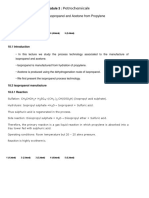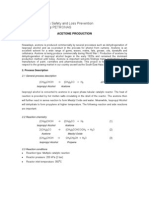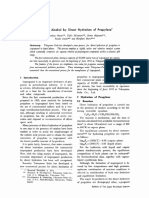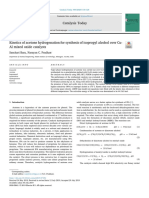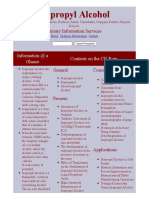0 ratings0% found this document useful (0 votes)
64 viewsLecture 18: Isopropanol and Acetone From Propylene: Module 3: Petrochemicals
This document discusses the production of isopropanol and acetone from propylene. Isopropanol is produced via the hydration of propylene using sulfuric acid in a gas-liquid reaction under high pressure. Acetone is then generated from isopropanol through dehydrogenation. The primary reactions for isopropanol production involve sulfation of propylene to form isopropyl acid sulfate, which then undergoes hydrolysis to form isopropanol and regenerate sulfuric acid.
Uploaded by
shamsullah hamdardCopyright
© © All Rights Reserved
Available Formats
Download as PDF, TXT or read online on Scribd
0 ratings0% found this document useful (0 votes)
64 viewsLecture 18: Isopropanol and Acetone From Propylene: Module 3: Petrochemicals
This document discusses the production of isopropanol and acetone from propylene. Isopropanol is produced via the hydration of propylene using sulfuric acid in a gas-liquid reaction under high pressure. Acetone is then generated from isopropanol through dehydrogenation. The primary reactions for isopropanol production involve sulfation of propylene to form isopropyl acid sulfate, which then undergoes hydrolysis to form isopropanol and regenerate sulfuric acid.
Uploaded by
shamsullah hamdardCopyright
© © All Rights Reserved
Available Formats
Download as PDF, TXT or read online on Scribd
You are on page 1/ 1
Module 3 : Petrochemicals
Lecture 18 : Isopropanol and Acetone from Propylene
1 (1.html) 2 (2.html) 3 (3.html) 4 (4.html) 5 (5.html)
18.1 Introduction
• In this lecture we study the process technology associated to the manufacture of
isopropanol and acetone.
• Isopropanol is manufactured from hydration of propylene.
• Acetone is produced using the dehydrogenation route of isopropanol.
• We first present the isopropanol process technology.
18.2 Isopropanol manufacture
18.2.1 Reaction
Sulfation: CH3CHCH2+ H2SO4→(CH3 )2 CH(OSO3H) (Isopropyl acid sulphate).
Hydrolysis: Isopropyl sulphate +H2O→ Isopropanol + Sulfuric acid.
Thus sulphuric acid is regenerated in the process.
Side reaction: Disiopropyl sulphate + H2O→ Diisopropyl ether + Sulfuric acid.
Therefore, the primary reaction is a gas liquid reaction in which propylene is absorbed into a
tray tower fed with sulphuric acid.
Operating conditions: Room temperature but 20 – 25 atms pressure.
Reaction is highly exothermic.
1 (1.html) 2 (2.html) 3 (3.html) 4 (4.html) 5 (5.html)
You might also like
- Production of Acetone Via The Dehydrogenation of Isopropyl Alcohol (IPA)50% (2)Production of Acetone Via The Dehydrogenation of Isopropyl Alcohol (IPA)4 pages
- Production of 100,00 Metrics Tonnes Per Year of N-Propanol50% (6)Production of 100,00 Metrics Tonnes Per Year of N-Propanol184 pages
- Lecture 18: Isopropanol and Acetone From Propylene: Module 3: PetrochemicalsNo ratings yetLecture 18: Isopropanol and Acetone From Propylene: Module 3: Petrochemicals1 page
- Catalytic Dehydration of Isopropanol To PropyleneNo ratings yetCatalytic Dehydration of Isopropanol To Propylene24 pages
- Hydration of Propylene Via Sulfation HydrationNo ratings yetHydration of Propylene Via Sulfation Hydration4 pages
- Production of Isopropanol: B.Sc. VI Sem Industrial ChemistryNo ratings yetProduction of Isopropanol: B.Sc. VI Sem Industrial Chemistry7 pages
- Production of Isopropyl Alcohol: by Joshua SuicoNo ratings yetProduction of Isopropyl Alcohol: by Joshua Suico3 pages
- Project 1 - Isopropanol and Acetone From Propylene PDFNo ratings yetProject 1 - Isopropanol and Acetone From Propylene PDF8 pages
- LECTURE - 7: Propylene Derivatives Isopropanol and Acetone From PropyleneNo ratings yetLECTURE - 7: Propylene Derivatives Isopropanol and Acetone From Propylene8 pages
- Lecture 18: Isopropanol and Acetone From Propylene: Module 3: PetrochemicalsNo ratings yetLecture 18: Isopropanol and Acetone From Propylene: Module 3: Petrochemicals2 pages
- Lecture 18 - Isopropanol and Acetone From PropyleneNo ratings yetLecture 18 - Isopropanol and Acetone From Propylene6 pages
- Acetone Reactor Design Complete Project PDFNo ratings yetAcetone Reactor Design Complete Project PDF29 pages
- Acetone Reactor Design Complete ProjectNo ratings yetAcetone Reactor Design Complete Project29 pages
- 1 2 3 Properties 4 Different Product From Ipa 5 Different Processes 6 Ipa by Indirect Hydration 7 Process Flow Diagram 8 Uses 9 Safety 10 Toxicology 11 ReferencesNo ratings yet1 2 3 Properties 4 Different Product From Ipa 5 Different Processes 6 Ipa by Indirect Hydration 7 Process Flow Diagram 8 Uses 9 Safety 10 Toxicology 11 References12 pages
- Production of 100,00 Metrics Tonnes Per Year of N-Propanol PDF0% (1)Production of 100,00 Metrics Tonnes Per Year of N-Propanol PDF90 pages
- Tokuyama Process (High Temp, High Pressure)No ratings yetTokuyama Process (High Temp, High Pressure)6 pages
- Technoeconomic Analysis of Alternative Pathways of Isopropanol ProductionNo ratings yetTechnoeconomic Analysis of Alternative Pathways of Isopropanol Production13 pages
- Kinetics of Acetone Hydrogenation For Synthesis of Isopropyl Alcohol Over Cu-Al Mixed Oxide CatalystsNo ratings yetKinetics of Acetone Hydrogenation For Synthesis of Isopropyl Alcohol Over Cu-Al Mixed Oxide Catalysts9 pages
- Acetone Reactor Design Complete ProjectNo ratings yetAcetone Reactor Design Complete Project29 pages
- Acetone: Made By-Shivang Patel (13BCH042) Vedant Patel (13BCH043)No ratings yetAcetone: Made By-Shivang Patel (13BCH042) Vedant Patel (13BCH043)37 pages
- Propylene, Propylene Oxide and Isopropanol: Course: Chemical Technology (Organic) Module VIINo ratings yetPropylene, Propylene Oxide and Isopropanol: Course: Chemical Technology (Organic) Module VII12 pages
- LR Petrochemical Technology I-For StudentsNo ratings yetLR Petrochemical Technology I-For Students60 pages
- Patent_application_molecule_synthesis_IPANo ratings yetPatent_application_molecule_synthesis_IPA5 pages
- Sustainable synthesis of ciclopentene derivatives through multicomponent reactions in continuous flow regimeFrom EverandSustainable synthesis of ciclopentene derivatives through multicomponent reactions in continuous flow regimeNo ratings yet
- Handbook of Composites from Renewable Materials, Design and ManufacturingFrom EverandHandbook of Composites from Renewable Materials, Design and ManufacturingNo ratings yet
- IHSM CEH Isopropyl Alcohol Sample Report 2009No ratings yetIHSM CEH Isopropyl Alcohol Sample Report 200936 pages
- ISOPROPYL ALCOHOL BY THE STRONG-ACID PROCESS - Chemical Agents and Related Occupations - NCBI BookshelfNo ratings yetISOPROPYL ALCOHOL BY THE STRONG-ACID PROCESS - Chemical Agents and Related Occupations - NCBI Bookshelf9 pages
- Mahmoud Wafik Sadik and Asmaa. A. HalemaNo ratings yetMahmoud Wafik Sadik and Asmaa. A. Halema15 pages
- Isopropyl-Alcohol-General, Process, Applications, Products, Patent, Consultants, Company Profiles, Reports, ProjectsNo ratings yetIsopropyl-Alcohol-General, Process, Applications, Products, Patent, Consultants, Company Profiles, Reports, Projects4 pages
- Mahmoud Wafik Sadik and Asmaa. A. HalemaNo ratings yetMahmoud Wafik Sadik and Asmaa. A. Halema15 pages





